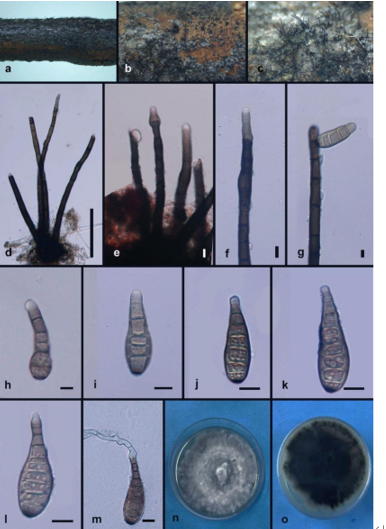Colletotrichum mengyinense T.C. Mu, J.W. Xia, X.G. Zhang & Z. Li, sp. Nov2021.
MycoBank No: 841265
Holotype:
Morphological description
Asexual morph: developed on SNA. A yellowish or orange mass appearing just as accumulations of conidia on the surface of the medium of SNA after 14 days in light at 25 °C. Conidia one-celled, hyaline, smooth-walled, subcylindrical, both ends round, contents granular. Conidia on SNA (12.5–15.7 × 4.8–6.1 µm, mean ± SD = 14.3 ± 1.1 × 5.3 ± 0.4 μm, L/W ratio = 2.7, n = 40).
Sexual morph not observed. Conidiogenous cells subcylindrical, hyaline, 5.3–15.5 × 2.9–4.9 μm, opening 1.7–2.5 μm diam. Conidiophores hyaline, smooth walled, septate, branched.
Cultures: Colonies on PDA flat with entire margin, aerial mycelium white or gray, floccose cottony; surface and reverse gray in the center and grayish margin. PDA attaining 69.3–75.6 mm in diameter after 7 days, at 25 °C, growth rate 9.9–10.8 mm/day. Colonies on SNA sparse hyphae, slow growth
Habitat: on diseased fruit of Juglans regia,
Distribution: China, Shandong Province: Mengyin County, on diseased fruit of Juglans regia, 25 July 2020, T.C. Mu, paratype HSAUP200912, exparatype living culture SAUCC200912. China, Shandong Province: Mengyin County, on diseased fruit of Juglans regia, 25 July 2020, T.C. Mu, paratype HSAUP200913, exparatype living culture SAUCC200913. China, Shandong Province: Mengyin County, on diseased fruit of Juglans regia, 25 July 2020, T.C. Mu, paratype HSAUP200983, ex-paratype living culture SAUCC200983
GenBank Accession: its MW786742; gapdh MW846240; gsh-1 MW883686;act MW883695 ;tub2 MW888970; cal MW922538 ; gs MW888961.
Notes: s. Phylogenetic analysis of a combined seven gene showed that Colletotrichum mengyinense formed an independent clade (Fig. 1) and is phylogenetically distinct from C. fructicola (Prihastuti et al. 2009). This species can be distinguished from C. fructicola by 40 different nucleotides (2/509 in the ITS region, 1/139 in the GAPDH region, 9/237 ACT, 8/410 TUB2 and 20/727 GS). What’s more, C. mengyinense differs from C. fructicola in having large conidia (12.5–15.7 × 4.8–6.1 vs. 9.7–14.0 × 3.0–4.3 μm, mean: 14.3 × 5.3 vs. 11.53× 3.55 μm). Therefore, we establish this fungus as a novel species
Reference: [1] Du, Z. , Fan, X. L. , Hyde, K. D. , Yang, Q. , Liang, Y. M. , & Tian, C. M. . (2016). Phylogeny and morphology reveal two new species of diaporthe from betula spp. in china. Phytotaxa, 269(2), 90.

Colletotrichum mengyinense (SAUCC200702) a branch with leaves of host plant b, c surface (b) and reverse (c) sides of colony after incubation for 7 days on PDA d conidiomata e-g conidiophores, conidiogenous cells and conidia h–j conidia. Scale bars: 10 μm (e–j)









